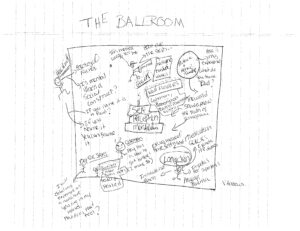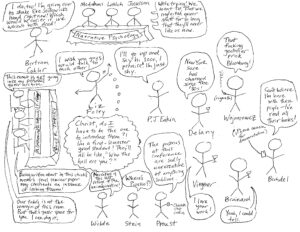You have hard copies already, but I figured I’d post the annotated bibliography guidelines here too.
Once you have completed your proposal and received feedback from me, the next phase of your research projects will be to compile an annotated bibliography–a list of sources you plan to cite, with a short explanation of what roles they’ll play in your essay.
Cornell University’s library offers a good overview of the genre of the annotated bibliography. It’s worth checking out.
For your annotated bibliographies, you should do the following:
- Create a full list of works you will cite, in alphabetical order, following MLA Guidelines for Works Cited entries).
- Write a few, concise sentences that explain how and why these sources will help you make your argument. For example, a source might help you establish motive or illustrate a point; it might provide background information or a counter-argument you want to address. Describe the source’s content as well as its functions in your essay. It may or may not be relevant to offer some details about the author (field of study, previous works, status, etc.).
- Explain which of Gaipa’s “8 strategies” (e.g. cross-breeding, leapfrogging) you’ll use with each source.
- Include a diagram of your “ballroom” of sources.
Ballroom Diagrams
It is precisely this metaphor—of criticism as a conversation—that I use to induct students into the world of scholarship. Early in the unit, I draw a square on the blackboard and tell students that we are peering into the ballroom of one of the plush hotels in Key West where the Hemingway Society is holding its annual convention. I then begin to fill in the square with stick figures, which I identify as the various authors represented in our critical readings. . . I have a few reasons for belaboring the metaphor in this way. First, I hope it personalizes the criticism by giving human faces (as it were) to the authors’ names; one cannot, after all, have a conversation with an abstraction. I also hope the metaphorical ballroom makes the overall field of criticism more visible to students: by collecting the criticism into a common frame, we recast the critics’ apparently disconnected arguments into a continuing exchange of ideas. Finally, I believe the metaphor offers students a clear path into the scholars’ debate: . . . first they have to enter the room and discern what the critics already inside are saying; then they have to evaluate the arguments and make some judgments about the position of authors and arguments in the critical terrain; and finally they need to discover where in the conversation they can step in.
–From Mark Gaipa’s “Breaking into the Conversation: How Students Can Acquire Authority in Their Writing”)
Venita Andrews, “Gaipa Ballroom Diagram” (Spring 2015)
Liz Foley, “Gaipa Ballroom Diagram” (Spring 2015)



